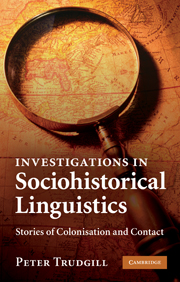Book contents
- Frontmatter
- Contents
- List of maps
- List of tables
- Acknowledgements
- Prologue: Colonisation and contact
- 1 What really happened to Old English?
- 2 East Anglian English and the Spanish Inquisition
- 3 On Anguilla and The Pickwick Papers
- 4 The last Yankee in the Pacific
- 5 An American lack of dynamism
- 6 Colonial lag?
- 7 “The new non-rhotic style”
- 8 What became of all the Scots?
- Epilogue: The critical threshold and interactional synchrony
- Bibliography
- Index
2 - East Anglian English and the Spanish Inquisition
Published online by Cambridge University Press: 02 December 2010
- Frontmatter
- Contents
- List of maps
- List of tables
- Acknowledgements
- Prologue: Colonisation and contact
- 1 What really happened to Old English?
- 2 East Anglian English and the Spanish Inquisition
- 3 On Anguilla and The Pickwick Papers
- 4 The last Yankee in the Pacific
- 5 An American lack of dynamism
- 6 Colonial lag?
- 7 “The new non-rhotic style”
- 8 What became of all the Scots?
- Epilogue: The critical threshold and interactional synchrony
- Bibliography
- Index
Summary
The geographical focus of this chapter is on one of the areas where the contact between Germanic and Brittonic (Brythonic) which we have just been discussing first occurred – namely the area of eastern England now known as East Anglia. Chronologically, however, the investigation starts where the previous one left off, in the Middle English period, and then takes us in terms of its principal focus up to the sixteenth and seventeenth centuries.
We start, however, by working backwards from the 1960s and 1970s, when East Anglian dialects of English had their brief moment of international academic glory. The big sociolinguistic issue of the day in the English-speaking world was the historical origins of African American Vernacular English (AAVE), or American “Nonstandard Negro English”, as it was then called. To simplify rather considerably, there were two major groups of American academic linguists in competition on this issue. One group, the Creolists, argued that, to the extent that AAVE was linguistically different from White varieties of English, this was due to the fact that AAVE had its origins in an earlier creole similar to Gullah and to the other English-based Atlantic creoles (Bailey 1965): AAVE was a decreolised creole or “post-creole” which still retained some creole features. The other group, who we can call the Dialectologists, argued that, without denying that Black and White varieties of American English differed, it was not necessary to postulate a creole history.
- Type
- Chapter
- Information
- Investigations in Sociohistorical LinguisticsStories of Colonisation and Contact, pp. 36 - 60Publisher: Cambridge University PressPrint publication year: 2010



